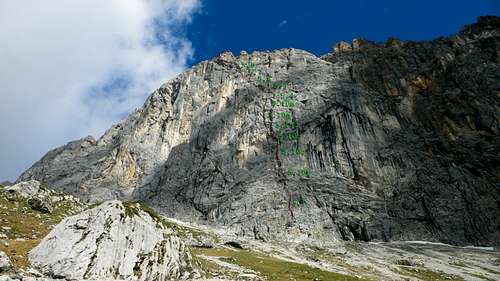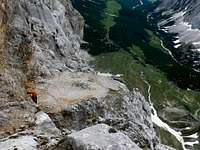|
|
Route |
|---|---|
|
|
47.39682°N / 11.11829°E |
|
|
Trad Climbing |
|
|
Spring, Summer, Fall |
|
|
Most of a day |
|
|
UIAA VII- or VI/A1 |
|
|
5.10c (YDS) |
|
|
12 |
|
|
IV |
|
|
Overview
First climbed in June of the astonishingly early year of 1934 by Rudolf Peters and H. Haringer, the Southeast Face offers 400 meters of vertical climbing in sharp cracks and corners. Views of the way ahead are always barred by overhangs which are snaked around or climbed over. The route features hand and finger cracks, a tough liebacking pitch, a slippery arm-barring off-width and a delicate stemming pitch. Mix in a series of connecting moves on slabby or dime-edge faces and you have a climb that still holds it's reputation as a kind of master's exam for difficult climbing.Perhaps owing to popularity, the route has been retrobolted to have solid belay anchors and several bolts per pitch. However, a rack of small to medium cams and nuts is advisable.
On our climb, we direct aided part of one pitch, finding that medium wired nuts were required to aid between the first and second bolts. For that reason I've marked the aid grade as A1 rather than A0 as I've seen in some guidebooks. Even so, the nut was difficult to place in a wet, flaring crack, and pulled when weighted, providing some excitement!
Getting There
Arrive at the south face of the Schüsselkarspitze by one of the southerly routes on the main Schüsselkarspitze peak page. The Puittal approach is the most efficient because you won't need to climb over and down from the Scharnitzjoch.Generally aim to reach the middle of the massive South/Southeast face a bit left of yellow overhangs dramatically stained black. A snaking crack line on gray rock goes between those features on the right and steep yellow rock on the left. Identify the leftward trend from the 9th pitch on a ledge that overhangs gray and yellow faces.
Route Description
 A topo in the YDS grading system. Enlarge and print the original image to get an idea of the approach and route.
A topo in the YDS grading system. Enlarge and print the original image to get an idea of the approach and route.Pitch one: - IV (YDS 5.7), 40 m - climb relatively low angle rock up the objective crack from a bolted belay stance 20 meters above the absolute base of the wall.
Pitch two: - VI+ (YDS 5.10b), 35 m - Easily up and left then surmount an overhang with good holds. A vertical face and crack provides the crux moves a bit below the belay.
Pitch three: - VII- (YDS 5.10c), 30 m - Hand jams on the right of a wide (often wet) crack, then face moves on the left lead to finger jams in a left-facing corner that climbs to the belay (a few moves of face climbing first).
Pitch four: - VII- (YDS 5.10c), 30 m - A wide gray crack leads to a gold handcrack and then an awkward (polished!) offwidth with a hidden handhold deep in the crack (just above an old piton that can be tempting to use for aid, vorsicht!!).
Pitch five: - VII- (YDS 5.10c), 40 m - A striking, curved and gently overhanging 20 meter corner crack begins the pitch. Liebacking is the preferred approach. If wet, using direct aid will be very tempting, though without high-stepping aiders some intermediate nut or small cam protection will be required. Above the corner crack, grade VI+ and VI crack climbing leads to lower angle terrain. At this point you need to traverse hard left to get into the crack system just left. A bolt marks the traverse location. Reach a good belay stance below a continuing vertical crack.
Pitch six: - VI (YDS 5.9/5.10a), 30 m - A solid crack pitch leads straight up, with an especially burly move in the middle, made secure by finger jamming.
Pitch seven: - VI (YDS 5.9), 40 m - A long steep corner offers hand jamming and sometimes delicate stemming on vertical rock. There are three bolts, but falls to the belay are possible without some additional nuts or cams due to wide spacing.
Pitch eight: - III+ (YDS 5.4), 30 m - The end of the difficulties for a while. Traverse right on the easiest line to a belay above a short steep corner.
Pitch nine: - III (YDS 5.3), 50 m - Traverse left and slightly up on a band taking the easiest line to the next belay station.
Pitch ten: - IV+ (YDS 5.6), 30 m - Traverse left, climbing a short harder step, then disappearing around a corner to a belay (don't skip this belay, rope drag would be grievous).
Pitch eleven: - V (YDS 5.7/5.8), 45 m - A short hard move at an overhang right off the belay, then easy ground to a belay beneath a dark, steep chimney.
Pitch twelve: - VI (YDS 5.9/5.10a), 30 m - Climb the chimney then out on the left face when it narrows to a hand crack. Delicate moves lead diagonally left to a belay where the angle of the face steps back.
Pitches 13-15: - II (YDS 4th), 150 m - Many climbers will unrope for this section, though belay stations are present. Follow your nose up and left, staying above a scree bowl and making for solid gray rock on the left side. Once attaining the crest, follow the West Ridge for about 10 meters back right to reach the summit.
Getting Down: - Follow the West Ridge to the Wangscharte below to the west. Without a detailed route description, we found that scrambling up and down along the ridge, and abseiling from anchors when it was too steep was enough to get us down in about 1.5 hours from the summit. Expect grade III (YDS 5.3) downclimbing along the ridge, with rappel stations when it's harder.
Essential Gear
Double 50 meter ropes are advisable.A medium rack of nuts and small to medium cams. A larger cam might be nice for the offwidth pitch, but the most difficult section is adequately protected by two bolts, provided it can be free climbed (rated VII- or VI+ depending on the topo source).




